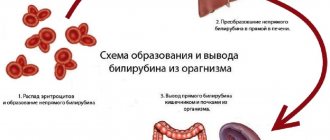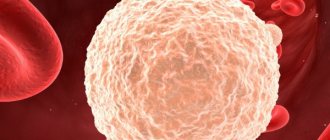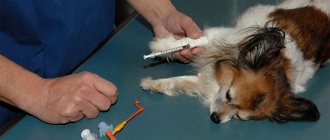Total protein
The interpretation of the analysis is done exclusively by the doctor. However, it also doesn’t hurt for the pet owner to know what this or that indicator means, because even a person far from medicine can understand what causes an increase or decrease in phosphatase or protein. The table provides information on the standard values of the UAC indicators and the reasons why each of them may be increased or decreased.
| Index | Standard values | Reasons for deviations of actual values from standard indicators | ||
| Lower threshold | Upper threshold | Downward | Upwards | |
| Hematocrit | 27% | 49% | Anemia, increased blood plasma concentration, inflammatory process, prolonged abstinence from eating, malignant tumor, condition after a drip | High red blood cell concentration, diarrhea, diabetes, decreased plasma quantity |
| Hemoglobin | 79 g/l | 149 g/l | Anemia, internal and external hemorrhages, poisoning of the body, disruption of the hematopoietic system, condition after a drip | Increase in the number of red blood cells, dehydration of the body |
| Red blood cells | 5.4x 10¹²/l | 10 x 10¹²/l | Anemia, bleeding, inflammation | Increased concentration of red blood cells, oxygen deficiency in the blood, consequences of liver and kidney dysfunction, dehydration of the body |
| Color index | 0,64 | 1,1 | Anemia | |
| Erythrocyte sedimentation rate (ESR) | 0 mm/h | 13 mm/h | An ESR value of zero indicates the absence of any pathologies | Inflammatory processes, myocardial infarction, cancer, intoxication of the body, damage to liver cells, kidney diseases, pregnancy, nervous system disorders, condition after surgery |
| Leukocytes | 5.4x109/l | 17.9x109/l | Viral infections, bone marrow diseases, radiation exposure | Bacterial infections, bleeding disorders, cancer, inflammation |
| Band neutrophils | 0% | 3,1% | None | Damage to the body by bacteria, purulent processes, blood clotting disorders, cancer, intoxication of the body |
| Eosinophils | 0% | 4,1% | Allergies (including to medications), parasitic diseases | |
| Basophils | Availability of at least one unit | Allergic reaction, dysfunction of the gastrointestinal tract, bleeding disorders | ||
| Monocytes | 1% | 4% | Anemia | Damage to the body by viruses, inflammation, postoperative period, tuberculosis |
| Lymphocytes | 19% | 56% | Cancerous tumors, decreased immunity, kidney diseases, liver diseases, blood pathologies | Infection, bleeding disorders, deterioration of the nervous system |
| Platelets | 300x109/l | 630x109/l | Genetic predisposition, infectious process, bone marrow diseases | Inflammation, cancer, bleeding, postoperative period |
Total protein is an organic polymer made up of amino acids.
The term “total protein” refers to the total concentration of albumin and globulins found in the blood serum. In the body, common protein performs the following functions: participates in blood clotting, maintains a constant blood pH, carries out a transport function, participates in immune reactions and many other functions.
Norms of total protein in the blood in cats and dogs: 60.0-80.0 g/l
a) acute and chronic infectious diseases,
b) oncological diseases,
c) dehydration of the body.
a) pancreatitis
b) liver diseases (cirrhosis, hepatitis, liver cancer, toxic liver damage)
c) intestinal disease (gastroenterocolitis), dysfunction of the gastrointestinal tract
d) acute and chronic bleeding
e) kidney disease, accompanied by significant loss of protein in the urine (glomerulonephritis, etc.)
f) decreased protein synthesis in the liver (hepatitis, cirrhosis)
g) increased protein losses due to blood loss, extensive burns, injuries, tumors, ascites, chronic and acute inflammation
h) cancer.
i) during fasting, intense physical exertion.
Types of blood tests, material studied
There are two main laboratory blood tests:
- general (or clinical);
- biochemical.
General (clinical) blood test for a cat
Shows the state of health of the body as a whole by the number and condition of formed blood elements. Also, this analysis can determine the presence of special parasites in the blood - hemobartenella and dirofilaria.
Basic indicators:
- hemoglobin;
- hematocrit;
- average content and concentration of hemoglobin in an erythrocyte;
- color indicator;
- ESR (erythrocyte sedimentation rate);
- leukocytes;
- red blood cells;
- neutrophils;
- lymphocytes;
- eosinophils;
- monocytes;
- platelets;
- basophils;
- myelocytes.
Material for analysis:
Venous blood of at least 2 ml, placed in a test tube with a special anticoagulant medium (heparin or sodium citrate), which prevents its coagulation and destruction of blood cells (blood cells).
Blood chemistry
Hidden pathologies in the cat’s body are revealed. The study provides information about damage to a particular organ or specific organ system, as well as an objective assessment of the extent of this damage. The result is determined by the work of the enzymatic system, reflected in the state of the blood. A biochemical blood test for a cat includes enzyme, electrolyte, fat and substrate indicators.
Basic indicators:
- glucose;
- protein and albumin;
- cholesterol;
- direct and total bilirubin;
- alanine aminotransferase (ALT)
- aspartate aminotransferase (AST);
- lactate dehydrogenase;
- gamma glutamyl transferase;
- alkaline phosphatase;
- ɑ-Amylase;
- urea;
- creatinine;
- calcium;
- magnesium;
- creatine phosphokinase;
- triglycerides;
- inorganic phosphorus;
- electrolytes (potassium, calcium, sodium, iron, chlorine, phosphorus).
Material for analysis:
Blood serum with a volume of about 1 ml (venous blood taken on an empty stomach and placed in a special tube that allows you to separate the blood serum from its formed elements).
Venous blood is drawn from the front or back paw by a veterinarian using topical anesthetic sprays. Usually it does not cause any discomfort to the pet if the doctor has certain skills.
Before a scheduled blood draw, the following should be excluded:
- excessive physical activity of the cat;
- administration of any medications the day before;
- any physiotherapeutic measures, ultrasound, x-rays and massages before the procedure;
- eating 8-12 hours before biochemical analysis.
Albumen
Albumin is the main blood protein produced in the liver of an animal. Albumin is classified into a separate group of proteins - the so-called protein fractions. Changes in the ratio of individual protein fractions in the blood often provide the doctor with more significant information than just total protein.
Albumin is 45.0-67.0% in the blood of cats and dogs.
1. An increase in albumin in the blood occurs with dehydration, loss of fluid from the body,
a) chronic liver diseases (hepatitis, cirrhosis, liver tumors)
b) intestinal diseases
c) sepsis, infectious diseases, purulent processes
d) burns
e) injuries
f) malignant tumors
g) heart failure
h) drug overdose
i) occurs as a result of starvation, insufficient intake of proteins from food.
Indicators and their interpretation
| Index | Unit | Value is normal |
| Hematocrit | % | 26-48 |
| Hemoglobin | g/l | 80-150 |
| Red blood cells | x 106/ml | 5,3-10 |
| Color index | — | 0,65-0,9 |
| ESR | mmh | 0-13 |
| Leukocytes | x 103/ml | 5,5-18,5 |
| Segmented neutrophils | % | 35-75 |
| Band neutrophils | % | 0-3 |
| Lymphocytes | % | 20-55 |
| Monocytes | % | 1-4 |
| Eosinophils | % | 0-4 |
| Basophils | — | rarely |
| Platelets | x 103/l | 300-630 |
| Name | Unit | Norm |
| Glucose | mmol/l | 3,3-6,3 |
| Protein | g/l | 54-77 |
| Albumen | g/l | 25-37 |
| Cholesterol | mmol/l | 1,6-3,7 |
| Total bilirubin | µmol/l | 3,0-12,0 |
| Direct bilirubin | µmol/l | 0-5,5 |
| Alanine aminotransferase | U/l | 19-79 |
| Aspartate aminotransferase | U/l | 9-29 |
| Lactate dehydrogenase | U/l | 55-155 |
| Alkaline phosphatase | U/l | 39-55 |
| Gamma glutamyl transferase | U/l | 5-50 |
| a-Amylase | U/l | 580-1720 |
| Urea | mmol/l | 2,0-8,0 |
| Creatinine | µmol/l | 70-165 |
| Phosphorus, inorganic | mmol/l | 0,7-1,8 |
| Calcium | mmol/l | 2,0-2,7 |
| Magnesium | mmol/l | 0,72-1,2 |
| Creatine phosphokinase | U/l | 150-798 |
| Triglycerides | mmol/l | 0,38-1,1 |
| Electrolytes: | ||
| Potassium (K) | mmol/l | 4,1-5,4 |
| Sodium (Na) | mmol/l | 143-165 |
| Calcium | mmol/l | 2,0-2,7 |
| Iron | mmol/l | 20-30 |
| Chlorine | mmol/l | 107-122 |
| Phosphorus | mmol/l | 1,1-2,3 |
Total protein (albumin and globulin). Protein is a structural unit of any living organism; without it, normal life activity is impossible. Amino acids, which make up protein, are involved in metabolic processes, transport of substances, perform a protective function, etc.
- Normal: 57.5-79.6 g/l.
- Above normal: dehydration due to vomiting, diarrhea, burns, myeloma.
- Below normal: limited supply of nutrients, exhaustion, impaired absorption function of the gastrointestinal tract, renal failure, large blood loss, oncology, abdominal dropsy, severe inflammatory process.
Albumin - participates in the transfer of substances and maintains balance in the body, is a kind of indicator of the functioning of the liver and kidneys.
- Norm: 25-39 g/l.
- Above normal: more common with dehydration (vomiting, diarrhea, burns).
- Below normal: hunger, cirrhosis, intestinal diseases when absorption function is impaired, intoxication.
Products of exchange
Bilirubin is a pigment toxic to cells, formed in the spleen (indirect) from decayed red blood cells; in the liver it is neutralized to harmless (direct) bilirubin and excreted from the body with bile. Determining the indicator helps to judge the functioning of liver cells.
- The norm of total bilirubin: 1.2-7.9 µm/l.
- Above normal: any liver damage, blockage of the bile ducts.
Direct bilirubin is a pigment associated with glucuronic acid, which is already excreted from the body by the kidneys.
- Normal: 0-5.1 µm/l.
- Above normal: indicates a latent liver disease, which has not yet manifested itself externally, that is, there is no characteristic jaundice; indicates the presence of stones in the gall bladder, possible oncology in the liver or gall bladder, degeneration of liver cells.
Creatinine is the final product of protein metabolism in muscles associated with energy production; It is toxic and is therefore excreted from the body by the kidneys.
- Norm: 130 µm/l.
- Above normal: kidney dysfunction, thyroid disease, poisoning, muscle destruction.
- Below normal: pregnancy, loss of muscle mass due to aging changes, possible development of cancer or cirrhosis of the liver.
Urea is residual nitrogen formed during the breakdown of protein and is excreted by the kidneys. This indicator is used to judge the functioning of the kidneys, liver (where urea is formed) and muscles (where protein breakdown occurs).
- Normal: 5-11 mmol/l.
- Above normal: dehydration, bleeding in the intestines, necrotic changes, kidney disease, prostatitis, ureteral obstruction, bladder stones, excessive protein intake, burns, heart disease.
- Below normal: insufficient protein intake, pregnancy, impaired absorption function in the intestines.
We invite you to familiarize yourself with: Balinese cat: photos, prices, description of the breed, character, video
Enzymes
Alkaline phosphatase is an enzyme (renal, bone, placental, hepatic intestinal), indicating the nature of phosphorus-calcium metabolism.
- Norm: 5-55 U/l.
- Above normal: pregnancy, changes occurring in the bones (fracture, fusion of bone tissue, rickets, oncology, etc.), problems with the liver and bile ducts.
- Below normal: thyroid disease, anemia, vitamin deficiency C and B.
Amylase is a digestive enzyme of the pancreas, which reflects the correct functioning of this organ. To a lesser extent, it helps determine the severity of liver disease. The analysis determines total amylase and pancreatic amylase.
- Norm: 500-1200 U/l.
- Above normal: inflammatory process in the pancreas, diabetes mellitus, inflammation of the abdominal wall.
- Below normal: weak pancreas function.
Lipase is another indicator of normal pancreatic function; an enzyme involved in the breakdown of fats in the digestive tract, energy metabolism and the absorption of certain vitamins.
- Normal: less than 50 U/l.
- Above normal: pancreatitis, obesity, diabetes mellitus, stomach ulcer, peritonitis.
- Below the norm: oncology, serious violations of feeding rules, when fats predominate in the diet, chronic pancreatitis.
ALT (alanine aminotransferase) is an enzyme that takes part in the metabolism of amino acids, is a source of energy for nerves, promotes the development of immunity and the production of lymphocytes. Contained in cardiac and skeletal muscles, liver.
- Norm: 8.3-52.5 U/l.
- Above normal: cirrhosis, jaundice, liver cancer, muscle disease, liver intoxication.
AST (aspartate aminotransferase) is another enzyme that takes an active part in protein metabolism. There is a lot of it in the liver, muscles, heart, and nerve cells. Released into the blood during serious pathological processes of any etiology.
- Norm: 9.2-39.5 U/l.
- Above normal: liver cell destruction, heart disease, heat stroke.
GGT (gamma-glutamyltransferase) is an amino acid transport enzyme, a kind of marker indicating a violation of the outflow of bile. The analysis is carried out if there is a suspicion of poor liver function against the background of a lethargic state, constant vomiting and diarrhea.
- Norm: 1-8 U/l.
- Above normal: liver disease, diabetes mellitus, pancreatitis, overactive thyroid gland.
Other indicators
Glucose is the energy depot of the entire body. The higher the physical and emotional stress, the more this substance is needed. The supply of glucose is especially important during recovery from illness, during growth and puberty. Large amounts of carbohydrate are absorbed by the heart, brain, and muscles.
The conductor of glucose to cells is the hormone insulin, produced in the pancreas, and adrenal corticosteroids “monitor” the concentration, neutralizing excess insulin if necessary.
- Normal: 4.3-7.3 mmol/l.
- Above normal: diabetes mellitus, stress, thyroid dysfunction, increased cortisol levels, diseases of the pancreas, kidneys and liver.
- Below normal: hunger strike, increased insulin concentration, disruption of pancreatic cells that produce insulin, oncology, disruption of the endocrine glands, intoxication with heavy metals.
Acid phosphatase is a marker of prostate cancer, and also indicates metastasis of all types of tumors into bone tissue or impaired hematopoiesis.
Normal: less than 50 U/l.
Cholesterol is a fat that is part of the cell membrane, maintaining its strength. It is necessary for the synthesis of hormones and bile acids; without it, it is impossible to regulate water and carbohydrate metabolism and the formation of vitamin D in the skin; it also helps to absorb calcium. Excess cholesterol is deposited in blood vessels, which promotes the formation of blood clots.
- Normal: 1.6-3.9 mmol/l.
- Above normal: dysfunction of the liver, thyroid gland, vascular disease, obesity.
- Below normal: cirrhosis, oncology, unbalanced diet.
Each indicator is responsible for one or another degree of health/illness in the cat’s body, and also shows the functioning of individual organs or entire systems. Not only does each data matter individually, but also in relation to each other.
- Hematocrit is a conditional indicator showing the ratio of all formed elements of blood to its total volume. Another name is the hematocrit number and often the ratio of not all blood cells, but only red blood cells, is determined. In other words, this is the thickness of the blood. Shows how much blood can carry oxygen.
- Hemoglobin is the content of red blood cells responsible for transporting oxygen throughout the body and removing waste carbon dioxide. Deviation from the norm is always a sign of one or another pathology in the circulatory system.
- The average concentration of hemoglobin in a red blood cell shows in percentage terms how much the red blood cells are saturated with hemoglobin.
- The average hemoglobin content in an erythrocyte has approximately the same value as the previous indicator, only the result is indicated by the specific amount of it in each erythrocyte, and not by the general percentage.
- The color (color) blood index shows how much hemoglobin is contained in red blood cells in relation to the normal value.
- ESR is an indicator by which traces of the inflammatory process are determined. The erythrocyte sedimentation rate does not indicate a specific disease, but indicates the presence of disorders. In which specific organ or system can be determined in conjunction with other indicators.
- Erythrocytes are red blood cells that take part in tissue gas exchange and maintaining acid-base balance. It’s bad when test results go beyond the norm, not only in the direction of decrease, but also of increase.
- Leukocytes - or white blood cells that indicate the state of the animal's immune system. Includes lymphocytes, neutrophils, monocytes, basophils, basophils and eosinophils. The relationship between all these cells among themselves is of diagnostic importance: neutrophils - responsible for destroying bacterial infections in the blood;
- lymphocytes – a general indicator of immunity;
- monocytes - are engaged in the destruction of foreign substances that enter the blood and threaten health;
- eosinophils - stand guard in the fight against allergens;
- basophils - “work” in tandem with other leukocytes, helping to recognize and identify foreign particles in the blood.
- Platelets are blood cells responsible for blood clotting. They are also responsible for the integrity of blood vessels. Both the growth of this indicator and its decrease are important.
- Myelocytes are considered a type of leukocyte, but they are a somewhat separate indicator, because are located in the bone marrow and should not normally be detected in the blood.
- Glucose is considered a very informative indicator, because indicates the functioning of a complex enzymatic system in the body, including individual organs. The glucose cycle involves 8 different hormones and 4 complex enzymatic processes. Pathology is considered to be both an increase in a cat’s blood sugar level and a decrease in it.
- Total protein in the blood reflects the correct amino acid (protein) metabolism in the body. Shows the total amount of all protein components - globulins and albumins. All proteins take part in almost all vital processes of the body, so both their quantitative increase and decrease are important.
- Albumin is the most important blood protein produced by the liver. Performs a lot of vital functions in the cat’s body, therefore it is always determined by an indicator separate from the total protein (transfer of useful substances, preservation of reserve reserves of amino acids for the body, preservation of osmotic pressure of the blood, etc.).
- Cholesterol is one of the structural components of cells, ensuring their strength, and is also involved in the synthesis of many vital hormones. It can also be used to judge the nature of lipid metabolism in a cat’s body.
- Bilirubin is a bile component consisting of two forms - indirect and direct. Indirect is formed from erythrocyte breakdown, and bound (direct) is converted in the liver from indirect. Directly shows the functioning of the hepabiliary system (biliary and hepatic). Refers to “color” indicators, because when it is exceeded in the body, the tissues turn yellow (a sign of jaundice).
- Alanine aminotransferase (ALT, ALaT) and aspartate aminotransferase (AST, ACaT) are enzymes produced by liver cells, skeletal muscles, heart cells and red blood cells. It is a direct indicator of the functions of these organs or departments.
- Lactate dehydrogenase (LDH) is an enzyme that is involved in the final step in the breakdown of glucose. Determined to monitor the functioning of the liver and cardiac systems, as well as the risk of tumor formation.
- ɤ-glutamyltransferase (Gamma-GT) – in combination with other liver enzymes, provides insight into the functioning of the hepabilary system, pancreas and thyroid glands.
- Alkaline phosphatase is determined to monitor liver function.
- ɑ-Amylase – produced by the pancreas and parotid salivary gland. Their work is judged by its level, but always in conjunction with other indicators.
- Urea is the result of protein processing, which is excreted by the kidneys. Some remains circulating in the blood. Using this indicator, you can check your kidney function.
- Creatinine is a muscle byproduct excreted from the body by the renal system. The level fluctuates depending on the condition of the urinary excretory system.
- Potassium, calcium, phosphorus and magnesium are always assessed in complex and in relation to each other.
- Calcium is involved in the conduction of nerve impulses, especially through the heart muscle. By its level, you can determine problems in the functioning of the heart, muscle contractility and blood clotting.
- Creatine phosphokinase is an enzyme that is found in large quantities in the skeletal muscle group. By its presence in the blood, one can judge the work of the heart muscle, as well as internal muscle injuries.
- Triglycerides in the blood characterize the functioning of the cardiovascular system, as well as energy metabolism. Usually analyzed in conjunction with cholesterol levels.
- Electrolytes are responsible for membrane electrical properties. Thanks to the electrical potential difference, cells pick up and execute commands from the brain. In pathologies, cells are literally “thrown out” from the nerve impulse conduction system.
We invite you to familiarize yourself with: Gopher: 90 photos and video descriptions of where and how wild and domesticated gophers live
Alpha globulins are normal 10.0-12.0%
Betta globulins 8.0-10.0%
Gamma globulins 15.0-17.0%
• Alpha globulins: 1. Increasing the fraction - during inflammatory processes (parasitic diseases, mycosis, dysbacteriosis). 2. Decrease in fraction – hypofunction of the thyroid gland, pancreatitis.
• Betta globulins: 1.Increasing the fraction - for hepatitis, cirrhosis and other liver damage.
• Gamma globulins: 1.Increasing the fraction in cirrhosis, hepatitis, infectious diseases.
2. Decrease in fraction - 14 days after vaccination, in case of kidney disease, in immunodeficiency states.
1. Type of acute inflammatory processes
A marked decrease in albumin content and an increased content of alpha globulins, an increase in gamma globulins.
It is observed in the initial stage of pneumonia, pleurisy, acute polyarthritis, acute infectious diseases and sepsis.
2. Type of subacute and chronic inflammation
Decrease in albumin content, increase in alpha and gamma globulins
Observed in late stages of pneumonia, chronic endocarditis, cholecystitis, urocystitis, pyelonephritis
3. Type of nephrotic symptom complex
Decrease in albumin, increase in alpha and beta globulins, moderate decrease in gamma globulins.
Lipoid and amyloid nephrosis, nephritis, nephrosclerosis, cachexia.
4. Type of malignant neoplasms
A sharp decrease in albumin with a significant increase in all globulin fractions, especially beta globulins.
Primary neoplasms of various localizations, metastases of neoplasms.
5. Type of hepatitis
Moderate decrease in albumin, increase in gamma globulins, sharp increase in beta globulins.
For hepatitis, the consequences of toxic liver damage (improper feeding, improper use of medications), some forms of polyarthritis, dermatoses, malignant neoplasms of the hematopoietic and lymphoid apparatus.
6. Type of cirrhosis
Significant decrease in albumin with a strong increase in gamma globulins
7. Type of mechanical (subhepatic) jaundice
A decrease in albumin and a moderate increase in alpha, beta and gamma albumin.
Obstructive jaundice, cancer of the biliary tract and head of the pancreas.
Norms of blood tests in cats
General (clinical) blood test
| The name of indicators | Units | Norm |
| % (l/l) | 26-48 (0,26-0,48) |
| g/l | 80-150 |
| % | 31-36 |
| pg | 14-19 |
| 0,65-0,9 | |
| mm/hour | 0-13 |
| million/µl | 5-10 |
| thousand/µl | 5,5-18,5 |
| % | 35-75 |
| % | 0-3 |
| % | 25-55 |
| % | 1-4 |
| % | 0-4 |
| million/l | 300-630 |
| % | — |
| % | — |
Blood chemistry
| The name of indicators | Units | Norm |
| mmol/l | 3,2-6,4 |
| g/l | 54-77 |
| g/l | 23-37 |
| mmol/l | 1,3-3,7 |
| µmol/l | 0-5,5 |
| µmol/l | 3-12 |
| U/l | 17(19)-79 |
| U/l | 9-29 |
| U/l | 55-155 |
| U/l | 5-50 |
| U/l | 39-55 |
| U/l | 780-1720 |
| mmol/l | 2-8 |
| mmol/l | 70-165 |
| mmol/l | 2-2,7 |
| mmol/l | 0,72-1,2 |
| U/l | 150-798 |
| mmol/l | 0,38-1,1 |
| mmol/l | 0,7-1,8 |
| Electrolytes | ||
| mmol/l | 3,8-5,4 |
| mmol/l | 2-2,7 |
| mmol/l | 143-165 |
| mmol/l | 20-30 |
| mmol/l | 107-123 |
| mmol/l | 1,1-2,3 |
ALT
ALT (ALT) or alanine aminotransferase is a liver enzyme that is involved in the metabolism of amino acids. ALT is found in the liver, kidneys, heart muscle, and skeletal muscles.
When the cells of these organs are destroyed, caused by various pathological processes, ALT is released into the blood of the animal's body. ALT norm in the blood of cats and dogs: 1.6-7.6 IU
a) toxic liver damage
b) cirrhosis of the liver
c) liver tumor
d) toxic effect on the liver of drugs (antibiotics, etc.)
e) heart failure
f) pancreatitis
g) shock
h) burns
i) trauma and necrosis of skeletal muscles
a) severe liver diseases - necrosis, cirrhosis (with a decrease in the number of cells synthesizing ALT)
b) vitamin B6 deficiency.
AST
AST (AST) or aspartate aminotransferase is a cellular enzyme involved in the metabolism of amino acids. AST is found in the tissues of the heart, liver, kidneys, nervous tissue, skeletal muscles and other organs.
The norm of AST in the blood is 1.6-6.7 IU
1. An increase in AST in the blood is observed if there is a disease in the body:
a) viral, toxic hepatitis
e) heart failure.
f) for skeletal muscle injuries, burns, heat stroke.
2. Decrease in the level of AST in the blood due to severe illness, liver rupture and vitamin B6 deficiency.
Alkaline phosphatase
Alkaline phosphatase is involved in the metabolism of phosphoric acid, breaking it down from organic compounds and promotes the transport of phosphorus in the body. The highest levels of alkaline phosphatase are in bone tissue, intestinal mucosa, placenta and mammary gland during lactation.
The normal level of alkaline phosphatase in the blood of dogs and cats is 8.0-28.0 MEL. Alkaline phosphatase affects bone growth, so its content is higher in growing organisms than in adults.
1. Increased alkaline phosphatase in the blood can be caused by
a) bone disease, including bone tumors (sarcoma), cancer metastases to bone
b) hyperparathyroidism
c) lymphogranulomatosis with bone lesions
d) osteodystrophy
e) liver diseases (cirrhosis, cancer, infectious hepatitis)
f) tumors of the biliary tract
g) lung infarction, kidney infarction.
h) lack of calcium and phosphates in food, from an overdose of vitamin C and as a result of taking certain medications.
2.Decreased alkaline phosphatase level
a) with hypothyroidism,
b) bone growth disorders,
c) lack of zinc, magnesium, vitamin B12 or C in food,
d) anemia (anemia).
e) taking medications can also cause a decrease in alkaline phosphatase in the blood.
Pancreatic amylase
Pancreatic amylase is an enzyme involved in the breakdown of starch and other carbohydrates in the lumen of the duodenum.
Pancreatic amylase norms are 35.0-70.0 G hour * l
a) acute, chronic pancreatitis (inflammation of the pancreas)
b) pancreatic cyst,
c) tumor in the pancreatic duct
d) acute peritonitis
e) diseases of the biliary tract (cholecystitis)
f) renal failure.
2. A decrease in amylase content can occur with pancreatic insufficiency, acute and chronic hepatitis.
Causes of kidney failure
Actually, PN itself is not essentially a disease. Renal failure is primarily a syndrome of dysfunction of the excretory system. This problem can result from:
- poisoning and intoxication;
- vasculitis, pyelonephritis in the kidney area;
- renal vessel stenosis;
- diabetes mellitus in old cats.
Animals may also have a hereditary predisposition to kidney failure. When buying an expensive cat, you should definitely ask about its pedigree.
Bilirubin
Bilirubin is a yellow-red pigment, a breakdown product of hemoglobin and some other blood components. Bilirubin is found in bile. Bilirubin analysis shows how the animal's liver works. Bilirubin is found in blood serum in the following forms: direct bilirubin, indirect bilirubin. Together, these forms form total blood bilirubin.
Norms of total bilirubin: 0.02-0.4 mg%
a) lack of vitamin B 12
b) liver tumors
c) hepatitis
d) primary cirrhosis of the liver
e) toxic, drug-induced liver poisoning
Calcium
Calcium (Ca, Calcium) is an inorganic element in the animal body.
• calcium supports normal heart rhythm, like magnesium, calcium contributes to the health of the cardiovascular system in general,
• participates in iron metabolism in the body, regulates enzyme activity,
• promotes normal functioning of the nervous system, transmission of nerve impulses,
We suggest you read: Vomiting in a cat, how to help a sick cat if it is vomiting
• phosphorus and calcium in balance make bones strong,
• participates in blood clotting, regulates the permeability of cell membranes,
• normalizes the functioning of some endocrine glands,
• participates in muscle contraction.
The normal level of calcium in the blood of dogs and cats: 9.5-12.0 mg%
Calcium enters the animal’s body with food; calcium absorption occurs in the intestines and metabolism in the bones. Calcium is removed from the body by the kidneys. The balance of these processes ensures a constant calcium content in the blood.
The excretion and absorption of calcium is controlled by hormones (parathyroid hormone, etc.) and calcitriol - vitamin D3. In order for calcium absorption to occur, the body must have enough vitamin D.
a) increased function of the parathyroid glands (primary hyperparathyroidism)
b) malignant tumors affecting bones (metastases, myeloma, leukemia)
c) excess vitamin D
d) dehydration
e) acute renal failure.
a) rickets (vitamin D deficiency)
b) osteodystrophy
c) decreased thyroid function
d) chronic renal failure
e) magnesium deficiency
f) pancreatitis
g) obstructive jaundice, liver failure
cachexia.
A lack of calcium can also be associated with the use of medications - antitumor and anticonvulsants.
Calcium deficiency in the body is manifested by muscle cramps and nervousness.
Symptoms of kidney failure
So, the cat's creatinine is elevated. We found out what this means. Of course, such tests usually cause the owner to worry about the condition of the animal’s kidneys. Only a veterinarian can diagnose deficiency. But the owner of the animal, with elevated creatinine readings, of course, needs to observe his pet himself. Symptoms of kidney failure include:
- constant unquenchable thirst;
- increased number of urinations;
- clarification of urine;
- periodic refusals to eat.
Sometimes an animal with PN may experience nausea and vomiting. This sign in itself does not indicate any disease. Cats specifically eat grass and various inedible things to cleanse their stomach. But in combination with other symptoms, this sign may also indicate the presence of PN.
At later stages, symptoms of deficiency may include:
- the cat's inability to swallow food;
- anorexia and dystrophy;
- damage to the nervous system due to toxins;
- the appearance of protein and blood in the animal’s urine;
- itching
Very often, cats with late-stage renal failure have very high blood pressure. And this, in turn, can lead to blindness due to rupture of blood vessels in the eyeball.
Phosphorus
Phosphorus (P) – necessary for the normal functioning of the central nervous system.
Phosphorus compounds are present in every cell of the body and are involved in almost all physiological chemical reactions. The norm in the body of dogs and cats is 6.0-7.0 mg%.
Phosphorus is part of nucleic acids that take part in the processes of growth, cell division, storage and use of genetic information,
phosphorus is contained in the bones of the skeleton (about 85% of the total amount of phosphorus in the body), it is necessary for the formation of the normal structure of teeth and gums, ensures the proper functioning of the heart and kidneys,
participates in the processes of accumulation and release of energy in cells,
participates in the transmission of nerve impulses, helps the metabolism of fats and starches.
The phosphorus content in the body is regulated by parathyroid hormone, calcitonin and vitamin D.
a) destruction of bone tissue (tumors, leukemia)
b) excess vitamin D
c) healing of bone fractures
d) decreased function of the parathyroid glands (hypoparathyroidism)
e) acute and chronic renal failure
f) osteodystrophy
g) acidosis
h) cirrhosis.
Phosphorus is usually higher than normal due to the use of anticancer drugs, which releases phosphates into the blood.
2. The lack of phosphorus must be regularly replenished by eating foods containing phosphorus.
a) lack of growth hormone
b) vitamin D deficiency (rickets)
c) periodontal disease
d) impaired absorption of phosphorus, severe diarrhea, vomiting
e) hypercalcemia
f) increased function of the parathyroid glands (hyperparathyroidism)
g) hyperinsulinemia (in the treatment of diabetes mellitus).
Glucose
Glucose is the main indicator of carbohydrate metabolism. More than half of the energy our body expends comes from the oxidation of glucose.
The concentration of glucose in the blood is regulated by the hormone insulin, which is the main hormone of the pancreas. With its deficiency, the level of glucose in the blood increases.
The glucose norm in animals is 4.2-9.0 mmol/l
a) diabetes mellitus
b) endocrine disorders
c) acute and chronic pancreatitis
d) pancreatic tumors
e) chronic liver and kidney diseases
f) cerebral hemorrhage
a) diseases of the pancreas (hyperplasia, adenoma or cancer)
hypothyroidism,
b) liver diseases (cirrhosis, hepatitis, cancer),
c) adrenal cancer, stomach cancer,
d) arsenic poisoning or overdose of certain medications.
A glucose test will show a decrease or increase in glucose levels after exercise.
Potassium
Potassium is found in cells, regulates water balance in the body and normalizes heart rhythm. Potassium affects the functioning of many cells in the body, especially nerve and muscle cells.
a) cell damage (hemolysis - destruction of blood cells, severe starvation, convulsions, severe injuries, deep burns),
b) dehydration,
c) shock,
d) acidosis,
e) acute renal failure,
f) adrenal insufficiency,
g) increasing the intake of potassium salts.
Typically, potassium is elevated due to taking antitumor, anti-inflammatory drugs and some other medications.
a) hypoglycemia
b) dropsy
c) chronic starvation
d) prolonged vomiting and diarrhea
e) renal dysfunction, acidosis, renal failure
f) excess of adrenal hormones
g) magnesium deficiency.
Urea
Urea is an active substance, the main breakdown product of proteins. Urea is produced by the liver from ammonia and is involved in the process of concentrating urine.
During the synthesis of urea, ammonia, a very toxic substance for the body, is neutralized. Urea is excreted from the body by the kidneys. The normal level of urea in the blood of cats and dogs is 30.0-45.0 mg%
a) kidney diseases (glomerulonephritis, pyelonephritis, polycystic kidney disease),
b) heart failure,
c) obstruction of urine outflow (bladder tumor, prostate adenoma, bladder stones),
d) leukemia, malignant tumors,
e) severe bleeding,
f) intestinal obstruction,
g) shock, fever,
h) burns.
An increase in urea occurs after physical activity, due to the intake of androgens and glucocorticoids.
2. Analysis of urea in the blood will show a decrease in urea levels in liver disorders such as hepatitis, cirrhosis, hepatic coma. A decrease in urea in the blood occurs during pregnancy, phosphorus or arsenic poisoning.
Creatinine
Creatinine is the end product of protein metabolism. Creatinine is formed in the liver and then released into the blood, participating in the energy metabolism of muscle and other tissues. Creatinine is excreted from the body by the kidneys in the urine, so creatinine is an important indicator of kidney activity.
The normal creatinine content in the blood of dogs and cats is 70.0-160.0 µmol/l
1. Increased creatinine is a symptom of acute and chronic renal failure, hyperthyroidism. Creatinine levels increase after taking certain medications, during dehydration, and after mechanical or surgical muscle damage.
2. A decrease in creatinine in the blood, which occurs during fasting, decreased muscle mass, during pregnancy, after taking corticosteroids.
Disadvantages of diagnostics
Normally, a cat’s blood creatinine should be 40-130 mmol/liter. But unfortunately, this indicator for such pets can actually fluctuate within very wide limits. In addition to the weight and activity of the pet, it can be influenced by the nature of the diet, breed characteristics, etc. In addition, the sensitivity of creatinine itself as an indicator of the state of the excretory system is considered not too high. Even with a 50% decrease in kidney filtration due to pathology, the level of this substance in the blood can remain almost normal.











